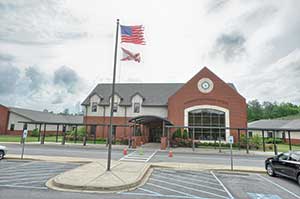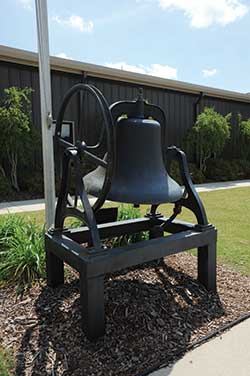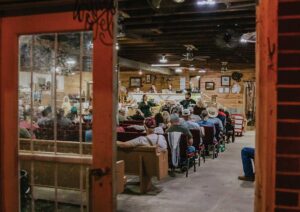
Blossoming boomtown of Margaret won’t be ‘Alabama’s best-kept secret’ for long
Story by Paul South
Photos by Wallace Bromberg Jr.
When Pastor Chris Crain was searching for a place to start a church in St. Clair County, a Trussville friend had a simple suggestion:
“You need to go to Margaret.”
Crain’s response: “Who’s she?”
You’ve never heard of Margaret, Ala.?” his friend asked.
“I drove out here, and I was shocked at the number of homes and people,” Crain said. “I think if there is a problem, it’s that people don’t know about Margaret.”
That was a decade ago. Today, Crain, 41, who began North Valley Church in Margaret with 16 people, now draws 400 worshippers on Sunday mornings.
The church is a microcosm of the boomtown that Margaret has become in recent years.
“One in every 10 people in Margaret is in our church on Sundays,” Crain says.
 The church is just one slice of the Margaret story. If economists, developers, community planners and visionaries could concoct a recipe for a boom, Margaret would be their masterpiece. New, affordable subdivisions, a state-of-the-art elementary school, virtually nonexistent crime and location, location, location have Margaret poised as one of the Birmingham metro area’s fastest growing municipalities in the first decade of this century, a perfect landing spot for young families and entrepreneurs.
The church is just one slice of the Margaret story. If economists, developers, community planners and visionaries could concoct a recipe for a boom, Margaret would be their masterpiece. New, affordable subdivisions, a state-of-the-art elementary school, virtually nonexistent crime and location, location, location have Margaret poised as one of the Birmingham metro area’s fastest growing municipalities in the first decade of this century, a perfect landing spot for young families and entrepreneurs.
The community grew by a whopping 278 percent from 2000-2010, from nearly 1,200 to more than 4,400. The city grew by nearly 8 percent between 2010 and 2015. Six percent growth is projected between now and 2020. More than 20,000 live within a five-mile radius of the city’s center. Margaret incorporated in 1960 and became a city in 2011.
Tucked between Interstates 20 and 59, Margaret is an easy hop for commuters who are moving to Margaret and St. Clair County. In the post-war period and into the 1980s, the Birmingham metro area grew southward over Red Mountain and into Shelby County. But in recent decades, all eyes seem to have turned eastward, putting Margaret in a prime spot to be a bedroom community for The Magic City.
Seventy-four-year-old real estate executive and developer Lyman Lovejoy, who’s sold and developed property in Margaret and throughout St. Clair County for more than four decades, is perhaps Margaret’s biggest cheerleader.
“Probably one of the best-kept secrets of what’s going on, even for the people who live here (in St. Clair County) is Margaret,” Lovejoy said. “You get off on the roads, and there’s 300 houses in one subdivision, 200 in another, 150 in another. Unless you get off the main road, you don’t know.”
At first blush, it would seem Margaret bucked historic trends. Charles DeBardeleben built the town around a coal mine at the turn of the 20th century. The Alabama Fuel and Iron mine – in the 1930s one of the most productive mines in Alabama – long ago played out. But unlike other towns built on coal, iron and steel that went as their industry did, Margaret not only survived, but now thrives. Location may have been Margaret’s saving grace when mining passed away.
“I think Margaret’s location as a coal mining community in a suburban growth region is the reason (growth) has taken place,” said Don Smith, executive director of the St. Clair County Economic Development Council. “Right now, as that growth around Birmingham’s urban core continues to intensify, it’s put Margaret right in that sweet spot. It has more to do with its location at this point in time than its history as a coal mining community.”
Visionaries apparently saw the sweet spot. Owners of huge tracts of land eventually sold acreage to ambitious developers. New subdivisions are being briskly built, bringing real estate bargains, and a desire for services and retail presence – a grocery store, restaurants, a doctor’s office, to name a few.
Telling the Margaret story to retailers and retail developers is an aim for the council, Smith said.
“One of the focuses that we have is to make sure that retail developers and retailers out there understand that Margaret is an underserved area as far as retail goes,” Smith said.
While many prime locations are now home to residential subdivisions, Smith believes there are other great locations available for commercial expansion.
Pharmacist Mark Ross and his wife Tracy took a leap of faith earlier this year to open Margaret Pharmacy. Lovejoy approached the couple last year about opening a drug store.
“I came out here, looked around, talked to people and just fell in love with the place,” Mark Ross said. “I fell in love with Margaret and the people here. My wife and I talked about it and prayed about it. It was just a matter of timing and Lyman Lovejoy’s foresight, I guess, that Margaret needed a pharmacy.”
Ross called his first four months in business, “phenomenal.”
“The people of Margaret have embraced us wholeheartedly. I can’t tell you the number of times I’ve been told, ‘A pharmacy was just what Margaret needed.’ ”
Ross has also heard something else in the voices of the townspeople that may say something about the future. Talk to people here long enough, and the vision for the city includes more eateries, a grocer, sports complexes and middle and high schools as Margaret’s kids grow up.
“They say, ‘Ahh, this is fantastic. This is the beginning of something great for Margaret.”
Margaret Mayor Isaac Howard III believes more great things are ahead for St. Clair’s boomtown. And the real ingredient that drives the little city’s success – its people.
“It’s really like a family network, the people who have lived here for years, and even the people who have moved in recently, they’ve formed a family network.”
People are really at the heart of Margaret’s success, a story that began more than a century ago. The Golden Rule that DeBardeleben based his business upon still thrives today in old-timers and newcomers alike.
 “For a lot of people out there, they’re looking for a safe, affordable place with good schools to raise their family. Margaret is that exact place they’re looking for, they just haven’t heard of it,” Lovejoy said. “I don’t know what else you’d ask for in a community.”
“For a lot of people out there, they’re looking for a safe, affordable place with good schools to raise their family. Margaret is that exact place they’re looking for, they just haven’t heard of it,” Lovejoy said. “I don’t know what else you’d ask for in a community.”
Gene Barker, building inspector for the City of Margaret for eight years, doesn’t either. He has seen the housing boom up close. In mid-May, there were 22 permitted new homes in various stages of construction.
Barker inspects the homes from foundation to roof and everything in between. He’s done as many as nine inspections on nine different homes in one day. Each house also involves multiple inspections. “That’s pretty much all I can handle,” he said.
A variety of factors have fueled the housing boom Barker sees on a daily basis. Low interest rates, more house for the money and geography – all play a role, Barker said. Margaret is eight miles off Interstate 59, and is also convenient to Interstate 20. Thirteen new houses have been permitted so far in 2016, according to city records. That’s a good year, Barker said.
“People are getting out of Birmingham,” he said. “They’ve got access to the interstates. The houses are reasonable. A lot of our buyers are young people.”
It is an easy, convenient commute. “It’s close to 59, but if you come over here in the mornings or afternoons, you see them coming from 59 and 20,” Barker said. “We try to cut the rights of way after 9 (a.m.), and we have to be done by 2 (p.m.), or you’ll get run over. It’s like a funeral procession.”
In 2005-2007, before the economic downturn, 26 different builders were working in Margaret. After the crash, the number plummeted to from three to seven per year. “It started to come back last year. So far, this is a good year,” Barker said.
With all the new that’s coming – and will come to Margaret – there’s still an homage to the town that the Welsh coal baron founded and named for his beloved wife, Margaret. The bell from the company-built community building now hangs at North Valley Church and still beckons stranger and friend to Margaret.
Said Pastor Chris Crain, “We still ring the bell.”
For more on Margaret and it’s history, read the full digital edition of Discover St. Clair online or get the print edition for Free.
















